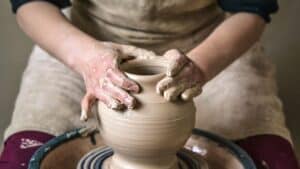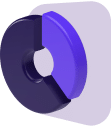In the world of Miniatures and Tabletop Games, 3D printers have a huge place that is only growing.
It was not very long ago that the quality was just not quite there. You had to accept the limitations or just take a pass on them altogether.
Things have definitely changed!
It’s an exciting time to jump into the 3D printer world. You can achieve very impressive quality prints with the current devices out there.
In this article, I’ll be sharing with you the best 3D printers on the market today, their capabilities, and which is best for what.
Why listen to me?
- I have personal experience with many 3D printers
- I’m plugged into the 3D tabletop & miniatures community
- Forums, groups, discords, channels – I’m constantly seeing what others are saying
So without further ado, here are the printers I’ll be covering and their best use-case:
- All-Around Best – Elegoo Saturn
- Budget Choice – Elegoo Mars 2 Mono
- Highest Quality – Phrosen Sonic Mighty 4k and Mini 4k
- Best FDM Printer for Terrain – Creality Ender 3 v2
- Best Resin Printer For Terrain – ANYCUBIC Photon Mono X
- All-Around Best – Elegoo Saturn
- Budget Choice – Elegoo Mars 2 Mono
- Highest Quality – Phrosen Sonic Mini 4k and Mighty 4k
- Best FDM Printer for Terrain – Creality Ender 3 v2
- Best Resin Printer For Terrain – ANYCUBIC Photon Mono X
- Which 3D Printer is Best for You
- The Top Resin (SLA) 3D Printers on the Market Right Now
- The Top Filament (FDM) 3D Printers
- on the Market Right Now
- Small….Medium…Large…What Size Do You Need?
- All About 3D Printers For Miniatures
- Filament FDM Printer vs. Resin SLA Printer
- Bed and Printing Size Limitations
All-Around Best – Elegoo Saturn
Love the Elegoo Saturn, in fact I’m a fan of Elegoo in general. So bear that in mind when you read this. I have other 3d printers but the Saturn is the current best all around Resin 3D printer for miniatures. It’s a great combination of size, quality and price.
Size: 192x120x200mm is a very nice print bed size. It’s not enormous, so you wont be doing huge terrain pieces or wearable cosplay in one full piece, but it’s big.
Price and Quality: It’s a large, 4k printer, for under $500.00. For what you get that’s a very good deal. This gives you a lot of room to do whatever you’re looking to print. Larger models, busts, terrain pieces, and more. All in high quality resin.
If you’re only looking to do smaller prints, I would suggest the other two Resin Printers in the round up, the Elegoo Mars 2 Mono or Phrosen Sonic Mini 4k. Let’s talk about those now:
Budget Choice – Elegoo Mars 2 Mono
If budget is a big concern, you’ll want to check out the wonderful Elegoo Mars 2 Mono. Under $250 as I type this is a steal. It’s a great resin printer. You’ll be very pleased if this is your first. Yes it has less resolution, and a smaller build plate, but excellent quality and enough room to do plenty of DnD figs, smaller terrain pieces, and whatever else you’re looking to print up.
Highest Quality – Phrosen Sonic Mini 4k and Mighty 4k
This is our former number 1, and it’s still REALLY close. It’s all a matter of size in this case (twss). The Phrosen Sonic Mini 4k is a smaller build plate with high quality prints. The question is, will you notice the 4k over say, a Elegoo Mars 2? Well, maybe. It really depends what you’re printing, the settings, the supports, and the resin you use. All things considered, if you want the cleanest you can get (within reason!), and not break the bank, this is the 3D printer to get.
If you’re looking for bigger, and can’t find the Saturn or prefer the Phrozen (they’re very close in quality and features), check out the
Best FDM Printer for Terrain – Creality Ender 3 v2
The lone FDM entry here is the venerable Creality Ender 3 V2. Again, this is an FDM, meaning not resin. It’s a filament extruding printer, which is a bit more fiddly to set up. The big value here though is the print bed is large (220x220x250) at about half the price of our bigger Resin printers like the Saturn. So you’re giving up a bit of detail, but you probably wont notice at all on terrain pieces.
If you need even more print space, consider the Creality CR-10S with a bed size of 300x300x400!! Thats a big boy, so make sure you have room for it.
Best Resin Printer For Terrain – ANYCUBIC Photon Mono X
This is a big, high quality resin printer. Slightly bigger than the Elegoo Saturn, 4k quality prints.
Which 3D Printer is Best for You
So beyond budget, here is the question you need to answer for yourself: What exactly do I want from this printer?
- Perfect high-quality miniatures at 28mm scale
- Large pieces of terrain for my tabletop wargame possibly even cosplay items?
- The ability to push out a lot of minis with respectable quality and not a lot of effort
- Easy to use, not a lot of work to get some miniatures for my tabletop
- Something that can do it all
Your answers will determine what is the best fit for your needs, but I’ll be giving you the best options that cover all the possibilities listed above.
- Do you want an FDM (filament) printer or SLA (resin) printer?
- How big of a printer bed do you need?
Filament (FDM) vs. Resin (SLA) Printers
| Filament (FDM) Printer | Resin (SLA) Printer | |
| Printing 28mm Miniatures | Solid quality prints. Can be upgraded and tweaked to improve quality. | Easily the best quality available for small models. |
| Printing Terrain Pieces | Very good at printing terrain. Available with larger bed size to accommodate bigger pieces. | Again excellent quality, however, smaller build plate limits sizes. |
| Easy To Use | Moderate learning curve to print, but easy to set up and remove once it’s printed. |
Learning curve to print, not too difficult to set up, more steps involved.
|
| Clean-Up and Safety | Safe and simple. No extra clean up required. |
Resin must be handled with gloves. Prints must be cleaned with Isopropyl Alcohol. Prints must be cured in sunlight or UV lights.
|
| Cost of Unit | Scales with build capacity: $200 – $800 | Under $300 for our top pick Under $500 for a step up in features. |
| Extra Items Needed | Filament spools for printing. | Resin, Isopropyl alcohol, Gloves, Disposing of Resin. |
I’ll define all this below for you. The short answer is FDM gives lesser detail but is a very simple process with not a lot of clean up or after print work.
Resin is very precise, crisp and smooth prints. Truly amazing quality… but requires a bit more work to get your final print. There is clean-up involved and curing to get the miniature fully ready to go.
Bed Size
The second decision is printer bed size. This is simply the size of the platform the printer can print on. It defines how big an item you can print, or how many items at once.
So if you want to print say a large piece of terrain, you’ll either need a bigger bed, or break it up into smaller pieces on a smaller printer and then assemble it.
I’m going to cut to the chase and give you the best options, and then we can dive into what exactly the reasoning is behind this decision:
The Top Resin (SLA) 3D Printers on the Market Right Now
[amazon table=”360″ link_id=”5139″]
These are the two big boys on the market today for Resin printers. They both have sizeable communities out there, with Anycubic being the larger of the two right now. Both are very similar in terms of how usable they are and the quality they deliver.
The Top Filament (FDM) 3D Printers
on the Market Right Now
[amazon table=”364″ link_id=”5140″]
The Prusa i3 is another FDM printer option to consider.
Small….Medium…Large…What Size Do You Need?
The real strength of the FDM printers are the size of the items you can print, and the dead simple way it’s done. The bed size determines how big of an item you can print:
| 3D Printer Model | Bed Size in MM | Bed Size in Inches |
| Mini Select V2 | 120 x 120 x 120mm | 4.7″ x 4.7″ x 4.7″ |
| Ender 3 | 220 x 220 x 250mm | 8.7″ x 8.7″ x 9.8″ |
| CR-10 | 300 x 300 x 400mm | 11.8″ x 11.8″ x 15.7″ |
Compare those to the Resins in our list:
Anycubic Photon: 115 x 65 x 155 mm
Elegoo Mars: 120 x 68 x 155 mm
So you can see the volume difference we’re talking about here.
The other benefit of FDM is how easy it is. You print your item, pop it off the bed, clean up any supports, and it’s ready to go.
A Resin you’re dealing with fumes from the resin, cleaning it in alcohol, curing it under UV lights or sunlight.
All About 3D Printers For Miniatures
Ok now let’s get into the nuts and bolts of 3D Printing so you can understand the basics.
There are two main technologies in 3D printing, FDM and SLA. Each one has its uses and both are popular for different reasons.
In this article, we’ll take an in-depth look at both of these 3D printing technologies and explain everything you need to know so you can decide which one will work best for you.
Filament FDM Printer vs. Resin SLA Printer
What Are FDM and SLA?
FDM is an acronym for Fused Deposition Modeling. A plastic strand, or filament, is placed through a hot extruder and then deposited in layers to create a 3d object.
To print the workpiece, the printer feeds the filament through a heated extruder to soften the plastic and lay it down layer by layer to create the finished object.
There is a wide range of FDM 3D printers that fit every budget. The low end starts at a few hundred dollars. Spools of filament are also affordable, starting at $25 per kilo.
The cost factor is one reason why FDM printers are popular with home-based users and makers.
SLA stands for Stereolithography Apparatus or just stereolithography.
This process builds layer by layer like FDM does, but it uses photopolymer – usually a liquid resin – which is then hardened with UV light or focused light.
The hardening process is called curing. In SLA, the printed object is built top to bottom, the model is lifted upward out of a liquid resin bath by a build platform.
SLA 3D printers are typically more expensive than FDM machines. Therefore, the SLA is more often used in professional settings than in home studios.
Prices have come down somewhat in recent years.
Printer Results: Smooth and Detailed or Not?
In general resin printers (SLA) offer a smoother and more detailed result than FDM printers.
In this section, we’ll cover the differences between the two printing methods and explain the differences in print resolution and smoothness.
With FDM Printers, Three Factors Affect the Detail and Smoothness of the Printed Model:
Nozzle Diameter: The diameter of the nozzle determines the amount of filament and the width of each line printed. Most 3D FDM printers come equipped with a 4mm nozzle, which is good for most printed models. However, you can get affordable sets of nozzles in various sizes.
XY Precision: FDM printers use a three-axis system to find the correct position for the print head, X, Y, and Z. The printing bed is Z-axis. The model is worked two-dimensionally on the X-Y plane. Depending on the brand of printer, the printing bed may move on either the X or Y-axis.
Layer Thickness: The bond between layers is a little weaker in FDM printing than it is with SLA. As the layers are added, there is a tendency for the top layers to weigh down and flatten the layers below.
For this reason, the object needs to support the weight of its layer, which can be regulated by the thickness of the layers. The accuracy of a print is also affected by the height of the layer.
FDM vs SLA Post Process: After the Print Is Complete
Whether you choose an FDM or SLA printer, you’ll need to do some post-processing of your model when the print is complete.
SLA printed objects require more post-processing steps than FDM printed objects.
FDM Miniature Post-Processing
With an FDM printer, post-processing is relatively easy compared with SLA. All you need to do is clip off any support sprues. You can finish by sanding any rough edges with sandpaper.
SLA Miniature Post-Processing
Post-processing an SLA printed object is more involved than for an FDM printed object.
The resins used in SLA printing are toxic, so you’ll need to take safety precautions before you work with an SLA printed object.
Use nitrile gloves to avoid skin contact and wear safety glasses to protect your eyes. If resin does come in contact with your skin, clean immediately with soap and water.
Clear your workspace to avoid resin spills. If resin does happen to spill, clean the area quickly before it has a chance to harden.
You can also protect your work area with a layer of plastic sheeting. It’s a good idea to ventilate your work area as SLA printing gives off fumes.
When the print comes out of the resin bath, it will be covered in the liquid resin. You’ll need to rinse it off to remove the uncured resin.
For a smooth clean finish, you can use an ultrasonic bath filled with isopropyl alcohol (ISA).
Alternatively, you can rinse your model in a tub of ISA, it will take two or three rinse cycles to clean all the residue from the surface of the model.
Next, remove the support structures from your model. You can snap them off or use flush cutters to get a clean edge.
Whichever method you use, there will be nubs left where the support sprues were connected. Sand the leftover nubs with sandpaper for a smooth finish.
The final step is the UV curing. You can use a curing station to do this or choose a more affordable option.
Most SLA printer manufacturers also sell curing stations. You can also use a nail polish lamp or put it out in the sun. If you choose the solar method it will take longer than it will under a lamp.
Bed and Printing Size Limitations
A printing bed or build plate creates a flat surface for the printer to use to build your model. There are several different surface types available for build plates, including glass, plastic, and metal.
The plastic forms a temporary bond with the build plate as the model is being printed. The size of your build plate limits the size and dimensions of your printed projects.
The smaller the plate, the smaller the print size.
It’s also worth noting that the print area dimensions listed by manufacturers will indicate the maximum allowable print size, but not the optimal print size for resolution and detail.
In other words, if you try to print a model at the maximum size, you will lose some print resolution.










